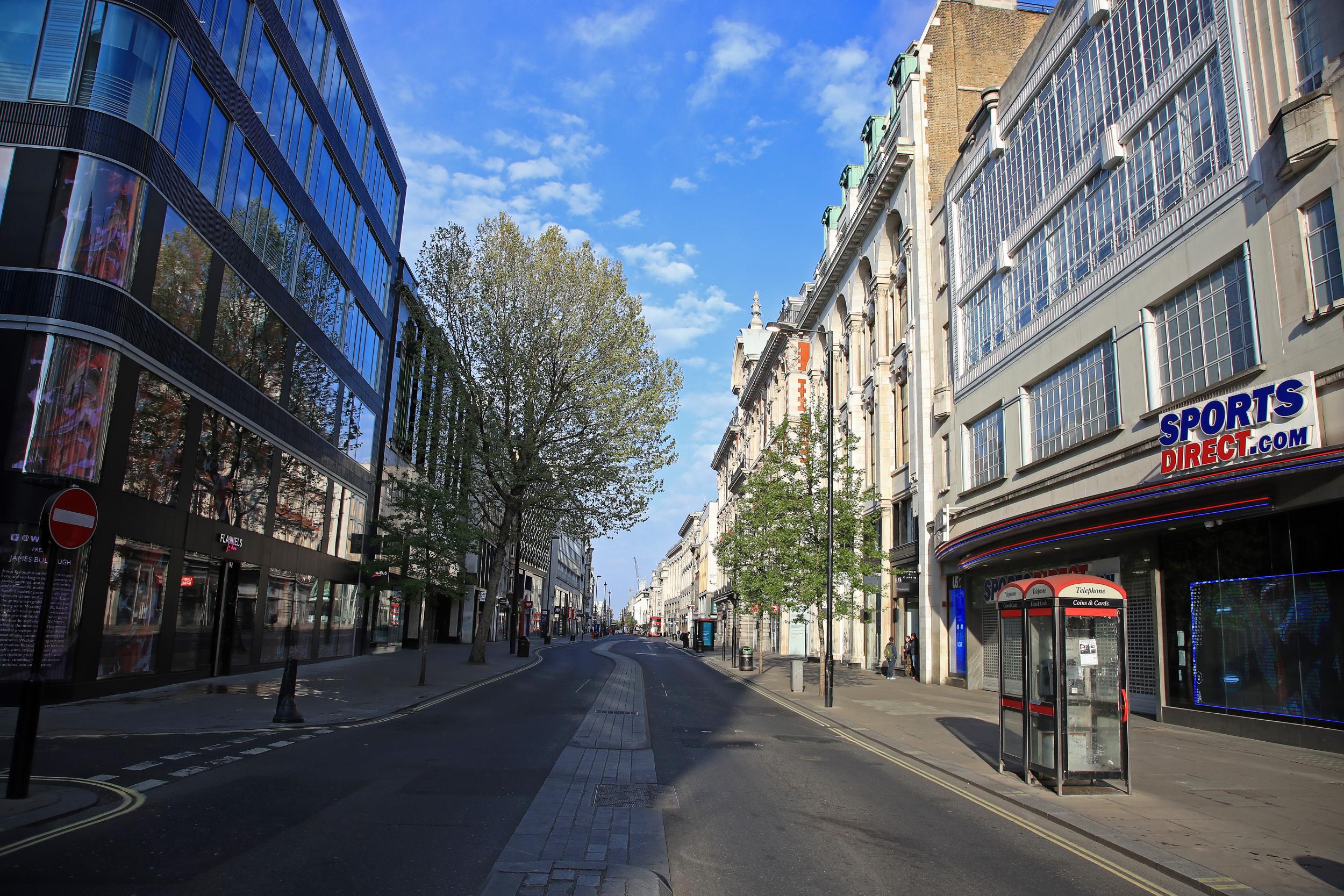Could Britain’s car-choked cities get more liveable because of the pandemic?
Measures introduced now to make cycling and walking easier should remain after pandemic, campaigners tell Jon Stone


Britain’s streets have been changed overnight by the coronavirus lockdown: in some places, normally busy shopping drags are devoid of people; rush-hour traffic jams have slowed to a trickle in all but the busiest areas.
Elsewhere, queues of people stocking up on essentials snake out of shops operating a one-in-one-out policy, and parks are filled with people going for their daily social-distanced walks, dodging each other.
“The way that people move has an impact on people around them and I think it’s never been more obvious than now,” Giulio Ferrini, head of urban design at Sustrans, a walking and cycling charity, tells The Independent.
“We’ve all seen the pictures of crowded footways because people are queueing for shops and the queues are spilling out onto the street because the footways are very narrow – because our roads have been designed mostly around cars.”
Across the world, cities are adapting to their residents’ new needs. Berlin is taking space away from motor traffic and widening its pavements so people can stand further apart, while Milan hit the headlines this week with an ambitious scheme to pedestrianise areas and throw up new bike lanes – a scheme its local government plans to make permanent.
“We worked for years to reduce car use. If everybody drives a car, there is no space for people, there is no space to move, there is no space for commercial activities outside the shops,” says Marco Granelli, one of Milan’s deputy mayors. “Of course, we want to reopen the economy, but we think we should do it on a different basis from before.”
Failing to change the way cities are structured now could have serious consequences for public safety – especially as restrictions start to ease.
“As the lockdown loosens a lot of people who own cars, the wealthier residents, will resort to the car as the default mode of transport – particularly with public transport not being seen as safe for a while,” urban designer Ferrini tells The Independent.
He suggests local authorities need to look at building networks of emergency protected cycle lanes to accommodate the number of people who will move from buses and rail for their journeys.
“If you look in London, the sheer number of people who usually commute by Tube and by bus – a lot of people will be trying to avoid that. A few will be wealthy and fortunate enough to own a car or be able to afford Ubers, but I think there’s a big social justice issue here ... the people who will have to return to work first are those who are maybe less wealthy and can’t work from home, and they’ll have to risk their lives, effectively – either going on public transport and risking contagion, or braving the newly trafficked streets.
“We’ve heard a lot of stories of people buying bikes for the first time and returning to cycling, and they can probably do it safely now because the roads are so quiet: but in a month’s time when the roads are suddenly busy and they’ve never ridden on trafficked roads but they want to avoid risk of contagion on the Tube or buses, there’ll be these new cyclists on the road with lots of traffic – and the potential risk to personal safety from that is really high.”
But public space is also an issue now. Moral panics on social media about people using parks during lockdown are just a reflection of the fact that often people have nowhere else to go.
“It’s quite obvious now, the pressure on parks and the pressure on public spaces,” says Ferrini. “A lot of people are walking to parks, but if the streets were safer for people to do exercise on there would be less need to walk around the parks.” The designer suggests closing residential streets to through traffic but putting bollards at one end, making them for residents only.
Councils are so stretched right now, people are being redeployed, there’s transport officers driving delivery vans to get food to homeless people. They shouldn’t be trawling through the Highways Act looking for the right regulation and arguing with lawyers
Just a few UK local authorities so far have been attentive to these problems. Brighton City Council, on the south coast, has closed a broad promenade on its sea front, Madeira Drive – that is normally choked with traffic. The local authority has posted stewards at the entrances to the street to tell people about the restrictions and urge them to social distance.
The aim, says councillor Anne Pissaridou, chair of the city’s transport committee, is to open up more space for people to exercise so that they are not crammed into existing parks.
“Madeira Drive is a long, wide road right by the seafront and will create an extra safe open space for local people in the area to use for their daily walk or bike ride,” she explains. “It will provide a traffic-free place for the many residents in that area who do not have access to a garden.”
Ms Pissaridou says the council was considering other locations “to see if we can extend this to other roads in the city”.
She adds: “Practising social distancing is making us all aware of the importance of public spaces and making us rethink how we use them.”
The London borough of Hammersmith and Fulham has also taken more unusual action – temporarily widening pavements on some of its busiest shopping streets, which are increasingly snaked with people queueing out of the door to buy essentials.
Long stretches of King Street and Uxbridge Road in the borough now have temporary barriers and weighted cones down them, cannibalising one of the traffic lanes for pedestrians. The council’s cabinet member for the environment, Wesley Harcourt, says the measures are temporary and will help people “queue safely when doing essential shopping”.
The Scottish government is also in discussions with local authorities about implementing pop-up bike lanes and widened footways in Edinburgh and Glasgow. But actually existing examples from the UK are fairly limited, partly due to the lengthy legal process that councils have to go through to make any serious changes.

Local authorities normally enact changes to road layouts with Traffic Regulation Orders (TROs) – but they take a long time to implement, with a statutory waiting period of 21 days to give time for people to object before any changes can be made. Sometimes they can take even longer and require a full public inquiry.
Councils do have workarounds, but none of them are perfect. One allows local authorities to temporarily restrict traffic – close roads, introduce bike lanes, widen pavement – using the powers they might used to close a road in the event of other threats to public safety like a gas leak or emergency work.
But these emergency TROs have to renewed every 21 days – with legal time and costs at each renewal, and a solid basis needed in each case. This was the approach taken by Brighton, who justified their closure on the basis that people exercising around speeding drivers is unsafe.
Councils can also introduce “experimental” orders, which can last up to 18 months – more suitable for the pandemic. But these are somewhat slower to implement, and intended to be used when there’s a plan to make a traffic change permanent – which lawyers say this could be cause problems when a council has no intention of doing so. Ultimately, the rules are a minefield.
“I think the government could do a little bit more – they could also just give a bit more clear guidance, because it’s a lot of legal-speak,” says Ferrini.
“They could clearly say – if you want to do this, we recommend this route, and we give you the confidence that this is the right way to do it. That could make those conversations a lot easier: councils are so stretched right now, people are being redeployed, there’s transport officers driving delivery vans to get food to homeless people.
“They shouldn’t be trawling through the Highways Act looking for the right regulation and arguing with lawyers. I think a bit more leadership in outlining the route could be helpful in offering to councils.”
The Department for Transport has published some advice to councils about traffic orders – but it is confined to how to advertise such orders (one of the many onerous legal requirements) under pandemic conditions.
The DfT in principle says it is very supportive of councils who want to allocate road space during the pandemic, with a spokesperson adding: “Cycling and walking are great ways to take your daily exercise or get to work, if you can’t work from home.
“We have published temporary guidance to help local authorities that want to give cyclists and pedestrians more space on roads during this current period.
“We hope that we will see a longer term uptake of cycling and walking and earlier this year we announced £5bn to improve bus and cycle links.”
The Local Government Association, which represents councils, told The Independent that it had long called for reform, and that “after the immediate emergency, we hope the government will seriously consider a new regime to help us create better streets for all”.
Failing to address these issues during the pandemic could cause other problems to get worse, Sustrans believes.
“We don’t have to lose track of the other challenges we’re facing because of the coronavirus pandemic: the obesity pandemic, social inequality, and the climate emergency,” says Ferrini.
“I think it’s really easy to focus on this pandemic and wait for things to go back to normal – but things won’t go back to normal, this pandemic will completely shift the way that people move around, their mobility choices.
“A lot of us will be working from home more often, a lot of us for the next year will be travelling in a way in which social distancing is a main criteria, and if we just wait for things to go back to normal we’ll find ourselves in a situation that’s way worse in terms of climate and equality.
“We just cannot afford to do that, I think we need to make sure we come out of this situation making sure we’ve done everything we can to step forward in those big societal challenges.”
Join our commenting forum
Join thought-provoking conversations, follow other Independent readers and see their replies
Comments
Bookmark popover
Removed from bookmarks